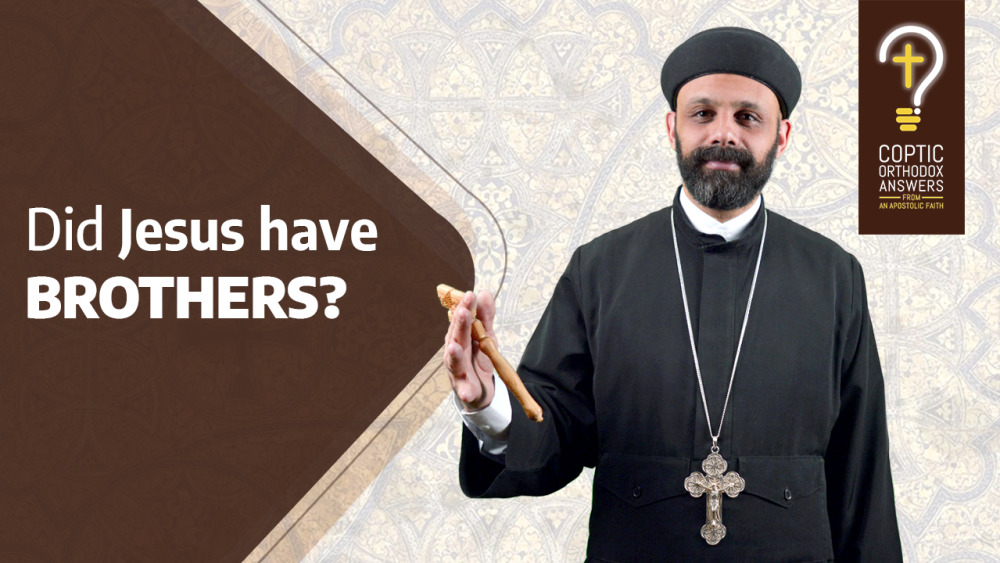Did Jesus have BROTHERS?
Did Jesus have biological brothers? In Matthew 1:25, it is written that “[Joseph] did not know Virgin Mary till she had brought forth her firstborn Son.” Also, Luke 2:7 mentions, “And she brought forth her firstborn Son.” Does that mean she has a second born and so on? In addition, Jesus’ brothers are named in Mark 6 and Matthew 13. So, did Jesus have biological brothers, as some believe, or is there more beneath the surface?
It is understandable where the confusion comes from. These verses do seem straightforward. But there’s more to them than meets the eye. In fact, even Martin Luther, the father of Protestantism, believed in the perpetual virginity of Saint Mary. He said the following: “Christ our Savior was the real and natural fruit of Mary’s virginal womb… without the cooperation of a man, and she remained a virgin after that.” But how can Martin Luther believe that? Because there is indeed an alternative explanation. Let’s first clarify the basic sources of confusion in the verses we have just referenced and I encourage you to watch the video till the end as we unfold the more substantial evidence which will provide a comprehensible answer. So let’s first examine Matthew 1:25, when Scripture says that Joseph did not know Mary till she had her firstborn. In today’s use of the English language, this verse might imply a relation after the birth of Christ but remember Scripture is not written today but approximately 2000 years ago. Languages and meanings evolve with time. Here, the Greek term translated as “until,” doesn’t necessarily contrast “before” and “after.” Back in the days, it signified something happening up to a certain moment, regardless of what occured afterward. For example, in the Greek translation of the Old Testament, the Septuagint, in 2 Samuel 6:23, it says that “Mikal had no children until the days of her death,” which doesn’t, of course, imply having children after her death. So, when St. Matthew uses “until,” he’s emphasizing that Jesus’ birth happened without any man’s intervention. It’s not about what happened after but what took place before the “until.” Similarly, the term “prôtotokos,” or “firstborn,” which is used in Matthew 1:25 and Luke 2:7, holds a unique legal and cultural meaning when applied to males. For instance, in Exodus 13:2, the Lord says, “Consecrate to me all the firstborn, whatever opens the womb among the children of Israel.” So a firstborn is defined by opening the womb of the mother and does not necessarily imply the child is first among siblings. In Jewish understanding, a child can be the first born and have no siblings.
Now, let’s unravel the complexity arising from the ancient Hebrew language’s ambiguity about the terms “brother” and “sister.” In ancient Hebrew, much like Aramaic, there isn’t a clear distinction between a blood brother and a cousin. The term “brother” essentially encompasses broader family relationships. Even nephews and nieces were called brothers and sisters as we see in Genesis 14:16 where Lot is referred to as the brother of Abraham, although he is in reality his nephew. Although the New Testament is written in Greek which is a language that does distinguish between brothers and cousins, we ought to remember that the authors write as per their own socio-cultural backdrop. Remember, the events written in Scripture were first lived and that life is rooted in their language, tradition, culture and so on. These authors were deeply rooted in Judaism, and when they used Greek words, they used them with Judaic understanding conveying their own Judaic perspective and, therefore, although, the term “cousin” is available in the Greek language, the authors still used the term “brother” because they have been identifying their cousins as brothers for the last 2 millennia. This will become apparent as we will see from Scripture itself that the brothers of Jesus are in fact his cousins.
Now let’s compare Matthew 13 and Matthew 27 for a deeper understanding of who were Christ’s brothers. In Matthew 13, we read that the brothers of Jesus were James, Joses, Simon, and Judas. In Matthew 27, while the Lord Jesus was on the cross, a few women were watching from afar, those were: Mary Magdalene, Mary the mother of James and Joses [Jesus’ brothers], and Salome, the mother of Zebedee’s sons. The Mary mentioned here, identified as the mother of James and Joses, cannot be the mother of Christ. It would be unthinkable that St. Matthew is referring to the mother of Christ who is watching her own Son on the cross and yet identifying her as the mother of James and Joses instead of the mother of Christ. Remember, the main event described, here, is the cross of Christ, who is God and the main character in this biography. Why would St. Matthew refer to Virgin Mary as the mother of James and Joses instead of the mother of Jesus? Also, from a Judaic perspective, this would be very abnormal. At that time, the mother would be identified primarily by the name of her firstborn which is, in this case, Jesus Himself. It would be very unlikely that she would be identified by the younger siblings. But that is not all. St. John in his gospel, provides an essential complementary detail. He also names the women standing at the cross but he identifies one additional Mary. He names Mary, Jesus’ mother, Mary the wife of Clopas who is St. Mary’s sister and Mary Magdalene. So who is standing next to St. Mary? Her own sister whose parents also named Mary after Virgin Mary was consecrated to the temple. That sister is the mother of James and Joses who is also the wife of Clopas. So, James and Joses are not biological brothers of Jesus; they are His cousins. And this is the view the early Church had all along and is found throughout the historical records. This insight also aligns with Christ’s actions on the cross where He entrusts Virgin Mary to St. John due to her having no more children. So, why does this all matter? It ties back to the profound intention of Virgin Mary to remain a virgin, a theme we encounter in her response to Archangel Gabriel at the Annunciation. When faced with the angelic proclamation, she responded: “How can this be, since I do not know a man?” This question demonstrates that she does understand how children are conceived. It is also a given who she would conceive through—meaning St. Joseph. These are facts at that point. Yet, she asks “How can this be?” St. Mary’s question goes beyond mere curiosity; it reflects her commitment to maintaining a life of virginity even while she is betrothed to St. Joseph. That was her wish all along.
Finally, St. Mary’s perpetual virginity is rooted in scripture and echoed by early Church Fathers who shed light on what the Church believed in the early centuries. While references to St. Mary’s perpetual virginity exist as far back as the second and third centuries, let’s focus on a few notable voices. Saint Athanasius boldly declared, “Let those who deny that the Son is by nature from the Father and proper to his essence deny also that he took true human flesh from the ever-virgin Mary” And then we have St. Didymus the Blind, shedding light on the terms ‘first-born’ and ‘only-begotten.’ He emphasized, “Mary remained a virgin ‘until she brought forth her first-born son,’ for neither did Mary marry anyone else nor did she become the mother of anyone else. Even after childbirth, she remained always and forever an immaculate virgin” There are countless others who bear witness to this truth.
Christian Answers Christianity COA Coptic Coptic Orthodox Answers Did Jesus have BROTHERS? james joses brothers jesus jesus brothers jesus brothers Baptist jesus brothers baptists jesus brothers cousins jesus brothers evangelical jesus brothers luther jesus brothers martin luther jesus brothers orthodox jesus brothers Pentecostal jesus brothers protestant martin luther mary clopas orthodox Orthodoxy Who are the brothers of Jesus

